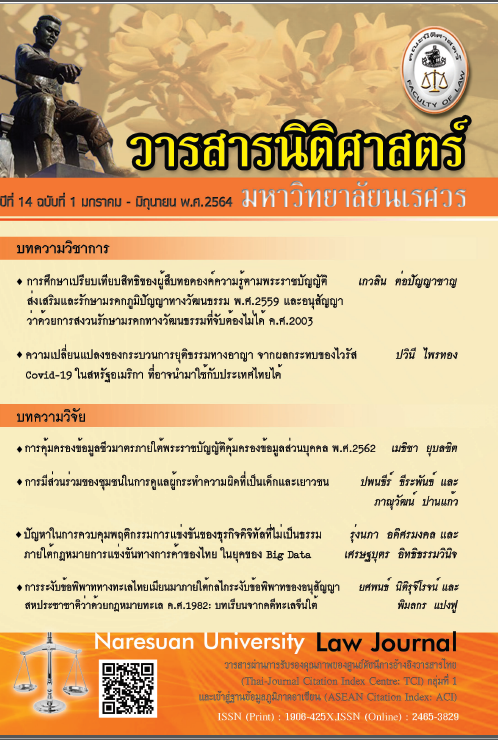Community Participation in Child and Juvenile Delinquents Care
Main Article Content
Abstract
Juvenile and Family Court and Procedure Act B.E. 2553 (2010), allows a community to participate in the process of rehabilitation plan-making in both pre-trial and post-trail. Public participation under the law, however, still has 3 problems. Firstly, it is the problem that the discretion of the director of juvenile observation and protection center is allowed to use to invite the community representative to join the rehabilitation plan making meeting. Secondly, it is the problem of the form of participation to care for the child and juvenile delinquents. Thirdly, it is the level of that community participation in child and juvenile delinquents’ care. Therefore, Juvenile and Family Court and Procedure Act B.E. 2553 (2010) should be amended to develop and encourage community participation in child and juvenile delinquents care by not giving the discretion to the director of juvenile observation and protection center. It should order the community representative to be a committee and to join the rehabilitation plan making meeting. There also should not be a limitation in the process of plan-making and action taking only, but following-up and assessment should be freely allowed. The law, moreover, should be amended or developed to allow the community to care for the child and juvenile delinquents as they expected and are ready.
Article Details
References
Achariya Chutinun. Law on Child, Juvenile and Family Cases. 3rd ed. Bangkok: Winyuchon, 2009. [inThai]
Boonchom Srisa-ard. “Assessment on the Use of Rating Scale Meausre.” Accessed June 2, 2020. https://edu.msu.ac.th/jem/home/journal_file/63.pdf. [inThai]
Cox, Steven M., Jennifer M. Allen, Robert D. Hanser, and John J. Conrad. Juvenile Justice: A Guide to Theory, Policy, and Practice. 7th ed. California: SAGE Publications, 2011.
Johnstone, Gerry, and Daniel W. Van Ness. Handbook of Restorative Justice. Devon: Willan Publishing, 2007.
Johnstone, Gerry. Restorative Justice: Ideas, Values, Debates. Devon: Willan Publishing, 2002.
Kanit Na Nakorn. Criminal Procedure Law. 9th ed. Bangkok: Winyuchon, 2018. [inThai]
Karp, David R., and Todd R. Clear. Community Justice: A Conceptual Framework. Washington, DC: United States Department of Justice, Office of Justice Programs, National Institute of Justice, 2000.
Korrakotch Narkwichet. The Study of the Model of Community Involving Community-Based Correction. Bangkok: Department of Probation, 2011. [in Thai]
Messmer, Heinz, and Hans-Uwe Otto. Restorative Justice on Trial: Pitfalls and Potentials of Victim-Offender Mediation-International Research Perspectives. Dordrecht: Kluwer Academic Publishers, 1992.
Mosquito, John Reyl L. Handling Child in Conflict with the Law (RA9344): Roles of the Barangay and SK. Quezon City: Central Book Supply, 2009.
Nirun Jongwuttivech. Public Participation for Development. Bangkok: Saksopha Printing, 1983. [inThai]
Sittichok Deachpibal. “Participation of the Local Community to Manage and Conserve the Environmental Quality of Mangrove Forest: A Study Exclusively of the Local Community in Phuket Province.” Master’s thesis, Thammasat University, 2011. [inThai]
United Nations. Handbook on Restorative Justice Programmes. New York: United Nations Publication, 2006.
Yamane, Taro. Statistics: An Introductory Analysis. 2nd ed. New York: Harper and Row, 1973.
Yud Sang-uthai. Handbook on Child Court Law. Pra Na Korn: Prachanithi Office, 1951. [inThai]


